《作物栽培学》课程教学资源(讲义)Cotton Growth and Development
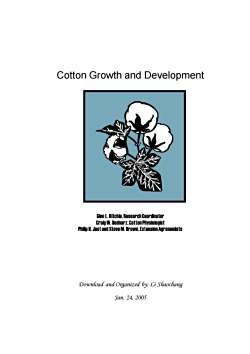
Cotton Growth and DevelopmentGlenL.Ritchie,ResearchCoordnatorCraig W.Bednarz,Cotton PhysiologistPhilip H.Jost and Steve M. Brown,Extension AgronomistsDownload and Organized by: Li ShaochangJan.24, 2005
Cotton Growth and Development Glen L. Ritchie, Research Coordinator Craig W. Bednarz, Cotton Physiologist Philip H. Jost and Steve M. Brown, Extension Agronomists Download and Organized by: Li Shaochang Jan. 24, 2005
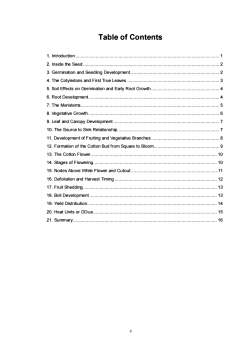
TableofContents1.Introduction52. Inside the Seed3. Germination and Seedling Development.2.34.TheCotyledonsandFirstTrueLeaves5.SoilEffectsonGerminationandEarlyRootGrowth46.RootDevelopment.7.The Meristems568.VegetativeGrowth9.LeafandCanopyDevelopment710.TheSourcetoSinkRelationship.811.DevelopmentofFruitingandVegetativeBranches12.FormationoftheCottonBudfromSquaretoBloom91013.TheCottonFlower14.StagesofFlowering...101115.NodesAboveWhiteFlowerandCutout1216. Defoliation and Harvest Timing.1317.Fruit Shedding..1318. Boll Development.19.Yield Distribution..141520.Heat Units or DD6S21.Summary16-
ii Table of Contents 1. Introduction . 1 2. Inside the Seed . 2 3. Germination and Seedling Development. 2 4. The Cotyledons and First True Leaves . 3 5. Soil Effects on Germination and Early Root Growth . 4 6. Root Development. 4 7. The Meristems. 5 8. Vegetative Growth. 6 9. Leaf and Canopy Development . 7 10. The Source to Sink Relationship. 7 11. Development of Fruiting and Vegetative Branches . 8 12. Formation of the Cotton Bud from Square to Bloom. 9 13. The Cotton Flower. 10 14. Stages of Flowering. 10 15. Nodes Above White Flower and Cutout .11 16. Defoliation and Harvest Timing . 12 17. Fruit Shedding. 13 18. Boll Development . 13 19. Yield Distribution. 14 20. Heat Units or DD60s. 15 21. Summary. 16
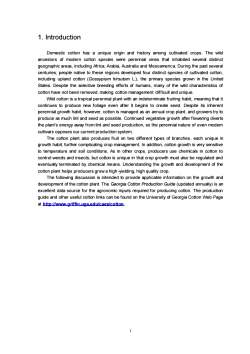
1.IntroductionDomestic cotton has a unique origin and history among cultivated crops. The wildancestors of modern cotton species wereperennial vines that inhabited several distinctgeographic areas,including Africa, Arabia, Australia and Mesoamerica. During the past severalcenturies, people native to these regions developed four distinct species of cultivated cotton,including upland cotton (Gossypium hirsutum L), the primary species grown in the UnitedStates.Despitethe selective breeding effortsof humans,manyof thewild characteristics ofcottonhave notbeenremoved,making cottonmanagementdifficultandunique.Wild cotton is atropical perennial plantwith an indeterminatefruiting habit,meaningthat itcontinues to produce new foliage even after it begins to create seed.Despite its inherentperennial growth habit, however, cotton is managed as an annual crop plant, and growers try toproduceasmuch lintand seed aspossible.Continued vegetativegrowthafterflowering divertsthe plant's energy away from lint and seed production, so the perennial nature of even modemcultivarsopposesourcurrentproductionsystemThecottonplantalsoproducesfruitontwo differenttypesof branches,eachuniqueingrowth habit,further complicating crop management. In addition,cotton growth is very sensitiveto temperature and soil conditions. As in other crops, producers use chemicals in cotton tocontrol weeds and insects, but cotton is unique in that crop growth must also be regulated andeventuallyterminatedbychemicalmeans.Understandingthegrowthanddevelopmentofthecotton plant helps producers grow a high-yielding, high quality crop.Thefollowing discussion is intended to provide applicable information on the growth anddevelopment of the cotton plant.The Georgia Cotton Production Guide (updated annually)is anexcellent data source for the agronomic inputs required for producing cotton. The productionguide and other useful cotton links can be found on the Universityof Georgia Cotton Web Pageathttp:l/www.griffin.ugaedu/caes/cotton
1 1. Introduction Domestic cotton has a unique origin and history among cultivated crops. The wild ancestors of modern cotton species were perennial vines that inhabited several distinct geographic areas, including Africa, Arabia, Australia and Mesoamerica. During the past several centuries, people native to these regions developed four distinct species of cultivated cotton, including upland cotton (Gossypium hirsutum L.), the primary species grown in the United States. Despite the selective breeding efforts of humans, many of the wild characteristics of cotton have not been removed, making cotton management difficult and unique. Wild cotton is a tropical perennial plant with an indeterminate fruiting habit, meaning that it continues to produce new foliage even after it begins to create seed. Despite its inherent perennial growth habit, however, cotton is managed as an annual crop plant, and growers try to produce as much lint and seed as possible. Continued vegetative growth after flowering diverts the plant’s energy away from lint and seed production, so the perennial nature of even modern cultivars opposes our current production system. The cotton plant also produces fruit on two different types of branches, each unique in growth habit, further complicating crop management. In addition, cotton growth is very sensitive to temperature and soil conditions. As in other crops, producers use chemicals in cotton to control weeds and insects, but cotton is unique in that crop growth must also be regulated and eventually terminated by chemical means. Understanding the growth and development of the cotton plant helps producers grow a high-yielding, high quality crop. The following discussion is intended to provide applicable information on the growth and development of the cotton plant. The Georgia Cotton Production Guide (updated annually) is an excellent data source for the agronomic inputs required for producing cotton. The production guide and other useful cotton links can be found on the University of Georgia Cotton Web Page at http://www.griffin.uga.edu/caes/cotton

2.Insidethe SeedAmaturecottonseed containsall oftheorgansnecessarytoproduceasmallseedling.Theseed is pointed on one end (theChalazamicropyle) and rounded on the other(thechalaza).Thetipof theprimaryroot,orradicle,facesthemicropyleand the precursors of thestemandGossypolGlandcotyledons are plainly visible withinthe seed (Figure 1).CotyledonThe chalaza istheprimary site ofEpicotylwater and oxygen absorption duringHypocotygermination. The tip of the primaryroot, or radicle, is the first part of theplantto emergethroughthemicropyleRadielThe cotyledons that will nourish thenew seedling are folded inside theMicropyleseed, with the hypocotyl below themFigure1.Asmall, dormant seedlingrests insideamatureready toelongateandpushtheseed. When the seedling emerges, the radicle wil be thethesoil.Theseedlingthroughprimary root,the hypocotyl will bethe stem underthe.cotyledons,andtheepicotylwillbethestemabovethegossypolglands visiblethroughout thecotyledonsfromwhichshootgrowthoccursinside of the seed are also visible inthe tissues of the growing plant.3.GerminationandSeedlingDevelopmentGermination begins as the seed absorbs water and oxygen through its chalaza afterplanting.Thewaterswellsthedormanttissues,andcellgrowthanddivisionbegintotakeplaceTheradicleemergesthroughthemicropyle,turnsdownward,andgrows deeperintothe soil,providing a taproot that will supply water and nutrients throughout the life of the plant (Figure 2aand b). The hypocotylelongates from the radicle and forms an arch or crook that begins to pushupthroughthesoil,abriefperiodoftenreferredtoasthe“crookstage"(Figure2c)Seedling emergence normally takes place 4 to 14 days after planting. At the soil surface,thehypocotyl straightens and pulls thefolded cotyledons out of the soil (Figure2d),a processknown as epigeal germination.Afterthe cotyledons are pulled through the soil surface,theyunfold and expose the epicotyl and the apical meristem, or growing point, which will be thesourceof subsequent growth (Figure2e-f).Atthispoint, germination and seedling emergencearecompleteandtheplantbegins itsactivevegetativegrowth.2
2 Figure 1. A small, dormant seedling rests inside a mature seed. When the seedling emerges, the radicle will be the primary root, the hypocotyl will be the stem under the cotyledons, and the epicotyl will be the stem above the cotyledons from which shoot growth occurs. 2. Inside the Seed A mature cotton seed contains all of the organs necessary to produce a small seedling. The seed is pointed on one end (the micropyle) and rounded on the other (the chalaza). The tip of the primary root, or radicle, faces the micropyle, and the precursors of the stem and cotyledons are plainly visible within the seed (Figure 1). The chalaza is the primary site of water and oxygen absorption during germination. The tip of the primary root, or radicle, is the first part of the plant to emerge through the micropyle. The cotyledons that will nourish the new seedling are folded inside the seed, with the hypocotyl below them ready to elongate and push the seedling through the soil. The gossypol glands visible throughout the inside of the seed are also visible in the tissues of the growing plant. 3. Germination and Seedling Development Germination begins as the seed absorbs water and oxygen through its chalaza after planting. The water swells the dormant tissues, and cell growth and division begin to take place. The radicle emerges through the micropyle, turns downward, and grows deeper into the soil, providing a taproot that will supply water and nutrients throughout the life of the plant (Figure 2a and b). The hypocotyl elongates from the radicle and forms an arch or crook that begins to push up through the soil, a brief period often referred to as the “crook stage” (Figure 2c). Seedling emergence normally takes place 4 to 14 days after planting. At the soil surface, the hypocotyl straightens and pulls the folded cotyledons out of the soil (Figure 2d), a process known as epigeal germination. After the cotyledons are pulled through the soil surface, they unfold and expose the epicotyl and the apical meristem, or growing point, which will be the source of subsequent growth (Figure 2e-f). At this point, germination and seedling emergence are complete and the plant begins its active vegetative growth
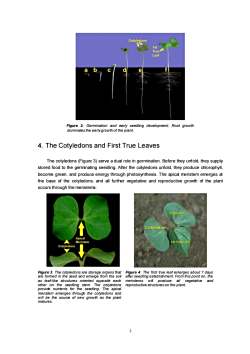
Figure 2.Germination and early seedling development.Rootgrowthdominatestheearlygrowthoftheplant.4.TheCotyledonsandFirstTrueLeavesThecotyledons (Figure 3)serve adual role ingermination.Before they unfold, they supplystoredfoodtothegerminatingseedling.Afterthecotyledonsunfold,theyproducechlorophyll,becomegreen,andproduceenergythroughphotosynthesis.Theapical meristememergesatthe base of the cotyledons,and all further vegetative andreproductive growth of the plantoccursthroughthemeristemsCotyledonCotyledonstTrueFigure3.Thecotyledonsarestorageorgans thatFigure4.The first true leaf emerges about7daysareformedintheseedandemergefromthesoilafterseedlingestablishment.Fromthispointon,theallvegetativeandasleaf-likestructuresoriented oppositeeachmeristemswillproduceother on theseedlingstem.Thecotyledonsreproductivestructuresontheplant.provide nutrients for the seedling. The apicalmeristem emerges through the cotyledons andwill be the source of new growth as the plantmatures.3
3 Figure 2. Germination and early seedling development. Root growth dominates the early growth of the plant. 4. The Cotyledons and First True Leaves The cotyledons (Figure 3) serve a dual role in germination. Before they unfold, they supply stored food to the germinating seedling. After the cotyledons unfold, they produce chlorophyll, become green, and produce energy through photosynthesis. The apical meristem emerges at the base of the cotyledons, and all further vegetative and reproductive growth of the plant occurs through the meristems. Figure 3. The cotyledons are storage organs that are formed in the seed and emerge from the soil as leaf-like structures oriented opposite each other on the seedling stem. The cotyledons provide nutrients for the seedling. The apical meristem emerges through the cotyledons and will be the source of new growth as the plant matures. Figure 4. The first true leaf emerges about 7 days after seedling establishment. From this point on, the meristems will produce all vegetative and reproductive structures on the plant
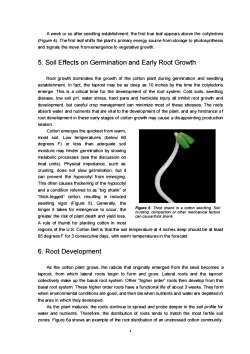
Aweekorsoafterseedlingestablishment,thefirsttrueleafappearsabovethecotyledons(Figure 4).Thefirst leaf shifts the plant's primary energy source from storage to photosynthesisandsignalsthemovefromemergencetovegetativegrowth.5.Soil Effects on Germination and EarlyRoot GrowthRoot growth dominates the growth of the cotton plant during germination and seedlingestablishment.Infact,thetaprootmaybeasdeep as1oinchesbythetimethecotyledonsemerge. This is a critical time for the development of the root system. Cold soils, seedlingdisease, low soil pH, water stress, hard pans and herbicide injury all inhibit root growth anddevelopment,but careful crop management can minimize most of these stresses.Therootsabsorbwater and nutrientsthatare vital tothedevelopmentof theplant,and anyhindrance ofroot development in these early stages of cotton growth may cause a disappointing productionseason.Cotton emerges the quickest from warm,moistsoil.Low temperatures(below 60degrees F)or less than adequate soilmoisture may hinder germination by slowingmetabolicprocesses(seethediscussiononheat units).Physical impedance,such ascrusting, does not slow germination, but itcan prevent the hypocotyl from emergingThis oftencausesthickening of thehypocotyland a condition referred to as “big shank" or"thick-legged"cotton, resulting in reducedseedling vigor (Figure 5)GenerallytheFigure5.Thickshankinacottonseedling.Soillonger ittakesfor emergence to occur,thecrusting,compactionorothermechanicalfactorsgreater the risk of plant death and yield loss.cancausethickshank.Arule of thumbforplantingcottoninmostregions of the U.S. Cotton Belt is that the soil temperature at 4 inches deep should be at least65degrees F for 3consecutive days, with warm temperatures in the forecast.6.RootDevelopmentAs the cottonplant grows,theradicle that originally emergedfromthe seed becomesataproot, from which lateral roots begin to form and grow.Lateral roots and the taprootcollectively make up the basal root system. Other"higher order"roots then develop from thisbasal rootsystem.Thesehigherorderrootshaveafunctional lifeof about3weeks.Theyformwhen environmentalconditionsaregood,andthendiewhennutrientsandwateraredepletedinthe area in which they developed.Astheplantmatures,theroots continueto spread andprobedeeper inthesoil profileforwater and nutrients.Therefore,the distribution of roots tends to match the most fertile soilzones.Figure6ashowsan exampleoftherootdistributionof anunstressedcottoncommunity.4
4 A week or so after seedling establishment, the first true leaf appears above the cotyledons (Figure 4). The first leaf shifts the plant’s primary energy source from storage to photosynthesis and signals the move from emergence to vegetative growth. 5. Soil Effects on Germination and Early Root Growth Root growth dominates the growth of the cotton plant during germination and seedling establishment. In fact, the taproot may be as deep as 10 inches by the time the cotyledons emerge. This is a critical time for the development of the root system. Cold soils, seedling disease, low soil pH, water stress, hard pans and herbicide injury all inhibit root growth and development, but careful crop management can minimize most of these stresses. The roots absorb water and nutrients that are vital to the development of the plant, and any hindrance o f root development in these early stages of cotton growth may cause a disappointing production season. Cotton emerges the quickest from warm, moist soil. Low temperatures (below 60 degrees F) or less than adequate soil moisture may hinder germination by slowing metabolic processes (see the discussion on heat units). Physical impedance, such as crusting, does not slow germination, but it can prevent the hypocotyl from emerging. This often causes thickening of the hypocotyl and a condition referred to as “big shank” or “thick-legged” cotton, resulting in reduced seedling vigor (Figure 5). Generally, the longer it takes for emergence to occur, the greater the risk of plant death and yield loss. A rule of thumb for planting cotton in most regions of the U.S. Cotton Belt is that the soil temperature at 4 inches deep should be at least 65 degrees F for 3 consecutive days, with warm temperatures in the forecast. 6. Root Development As the cotton plant grows, the radicle that originally emerged from the seed becomes a taproot, from which lateral roots begin to form and grow. Lateral roots and the taproot collectively make up the basal root system. Other “higher order” roots then develop from this basal root system. These higher order roots have a functional life of about 3 weeks. They form when environmental conditions are good, and then die when nutrients and water are depleted in the area in which they developed. As the plant matures, the roots continue to spread and probe deeper in the soil profile for water and nutrients. Therefore, the distribution of roots tends to match the most fertile soil zones. Figure 6a shows an example of the root distribution of an unstressed cotton community. Figure 5. Thick shank in a cotton seedling. Soil crusting, compaction or other mechanical factors can cause thick shank
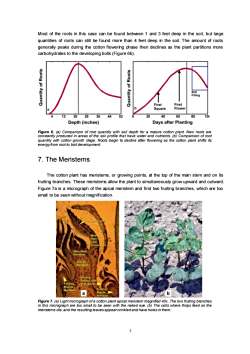
Mostof theroots in this case canbe found between1and3feetdeep in the soil,but largequantitiesof rootscanstill befound morethan4feetdeep inthesoil.Theamount of rootsgenerallypeaksduringthecottonfloweringphasethendeclinesastheplantpartitionsmorecarbohydratestothedevelopingbolls(Figure6b)oeBollFillingFirstFirstFlowerSquare20364452406080101122028Depth(inches)DaysafterPlantingFigure6.(a)Comparisonofrootquantitywithsoil depthfora maturecottonplantNewrootsareconstantlyproducedinareasofthesoilprofilethathavewaterandnutrients.(b)Comparisonofrootquantity with cotton growth stage.Roots begin to declineafter flowering as the cotton plant shits itsenergyfromroottobolldevelopment.7.The MeristemsThecottonplanthasmeristems,orgrowingpoints,atthetopofthemainstemandonitsfruitingbranches.Thesemeristems allowtheplantto simultaneouslygrowupward andoutwardFigure7aisamicrographof theapicalmeristemandfirsttwofruitingbranches,whicharetoosmalltobeseenwithoutmagnificationDFigure7.(a)Lightmicrographofacottonplantapicalmeristemmagnified40x.Thetwofruitingbranchesinthismicrographaretoosmall tobe seen withthenakedeye.(b)The cells wherethrips feed on themeristemsdie,andtheresultingleavesappearcrinkledandhaveholesinthem.5
5 Most of the roots in this case can be found between 1 and 3 feet deep in the soil, but large quantities of roots can still be found more than 4 feet deep in the soil. The amount of roots generally peaks during the cotton flowering phase then declines as the plant partitions more carbohydrates to the developing bolls (Figure 6b). Figure 6. (a) Comparison of root quantity with soil depth for a mature cotton plant. New roots are constantly produced in areas of the soil profile that have water and nutrients. (b) Comparison of root quantity with cotton growth stage. Roots begin to decline after flowering as the cotton plant shifts its energy from root to boll development. 7. The Meristems The cotton plant has meristems, or growing points, at the top of the main stem and on its fruiting branches. These meristems allow the plant to simultaneously grow upward and outward. Figure 7a is a micrograph of the apical meristem and first two fruiting branches, which are too small to be seen without magnification. Figure 7. (a) Light micrograph of a cotton plant apical meristem magnified 40x. The two fruiting branches in this micrograph are too small to be seen with the naked eye. (b) The cells where thrips feed on the meristems die, and the resulting leaves appear crinkled and have holes in them
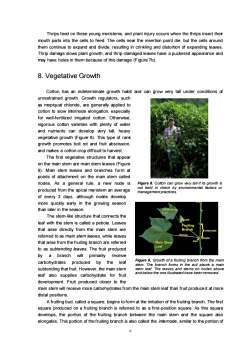
Thripsfeed ontheseyoungmeristems,and plant injury occurs whenthethrips inserttheirmouth parts into the cells to feed. The cells near the insertion point die, but the cells aroundthem continue to expand and divide,resulting in crinkling and distortion of expanding leaves.Thrip damage slows plant growth,and thrip-damaged leaves have a puckered appearance andmayhaveholesinthembecauseofthisdamage(Figure7b).8.Vegetative GrowthCotton has an indeterminate growth habit and can grow very tall under conditions ofunrestrained growth.Growth regulators,suchas mepiquat chloride, are generally applied tocotton to slow internode elongation, especiallyfor well-fertilized irrigated cotton.Otherwisevigorous cotton varieties with plenty of waterand nutrients can develop very tall, heavyvegetative growth (Figure 8).This type of rankgrowthpromotes boll rotand fruit abscission,andmakesacottoncropdifficulttoharvest.The first vegetative structures that appearonthemainstemaremainstemleaves(Figure9).Mainstemleavesandbranchesform atpoints of attachment onthe main stem callednodes. As a general rule, a new node isFigure8.Cotton can grow verytall if its growth isnotheld incheck by environmental factors orproducedfrom theapical meristeman averagemanagementpractices.of every3days,although nodesdevelopmorequicklyearly in the growing seasonthanlaterintheseason.Thestem-likestructurethatconnectstheleafwiththestemiscalledapetiole.LeavesFruitingthat arise directlyfrom the main stem areRralreferredtoasmainstemleaves,whileleavesthat arisefromthefruiting branch are referredinStenLeafto as subtending leaves. The fruit producedbyabranchwillprimarilyreceiveFigure9.Growth of a fruiting branch from themaincarbohydratesproducedbytheleafstem.Thebranchforms intheaxil aboveamainsubtendingthatfruit.However,themain stemstemleafTheleavesandstemsonnodesaboveandbelowtheoneillustratedhavebeenremovedleaf also supplies carbohydrate for fruitdevelopment. Fruit produced closer to themainstemwill receivemorecarbohydratesfromthemainstemleafthanfruitproducedat moredistal positions.Afruitingbud,calledasquare,beginstoformatthe initiationofthefruitingbranch.Thefirstsquare produced on a fruiting branch is referred to as a first-position square. As this squaredevelops,the portion of thefruitingbranchbetweenthemain stem and the square alsoelongates.Thisportionofthefruitingbranchisalsocalledtheinternode,similartotheportionof6
6 Thrips feed on these young meristems, and plant injury occurs when the thrips insert their mouth parts into the cells to feed. The cells near the insertion point die, but the cells around them continue to expand and divide, resulting in crinkling and distortion of expanding leaves. Thrip damage slows plant growth, and thrip-damaged leaves have a puckered appearance and may have holes in them because of this damage (Figure 7b). 8. Vegetative Growth Cotton has an indeterminate growth habit and can grow very tall under conditions of unrestrained growth. Growth regulators, such as mepiquat chloride, are generally applied to cotton to slow internode elongation, especially for well-fertilized irrigated cotton. Otherwise, vigorous cotton varieties with plenty of water and nutrients can develop very tall, heavy vegetative growth (Figure 8). This type of rank growth promotes boll rot and fruit abscission, and makes a cotton crop difficult to harvest. The first vegetative structures that appear on the main stem are main stem leaves (Figure 9). Main stem leaves and branches form at points of attachment on the main stem called nodes. As a general rule, a new node is produced from the apical meristem an average of every 3 days, although nodes develop more quickly early in the growing season than later in the season. The stem-like structure that connects the leaf with the stem is called a petiole. Leaves that arise directly from the main stem are referred to as main stem leaves, while leaves that arise from the fruiting branch are referred to as subtending leaves. The fruit produced by a branch will primarily receive carbohydrates produced by the leaf subtending that fruit. However, the main stem leaf also supplies carbohydrate for fruit development. Fruit produced closer to the main stem will receive more carbohydrates from the main stem leaf than fruit produced at more distal positions. A fruiting bud, called a square, begins to form at the initiation of the fruiting branch. The first square produced on a fruiting branch is referred to as a first-position square. As this square develops, the portion of the fruiting branch between the main stem and the square also elongates. This portion of the fruiting branch is also called the internode, similar to the portion of Figure 8. Cotton can grow very tall if its growth is not held in check by environmental factors or management practices. Figure 9. Growth of a fruiting branch from the main stem. The branch forms in the axil above a main stem leaf. The leaves and stems on nodes above and below the one illustrated have been removed
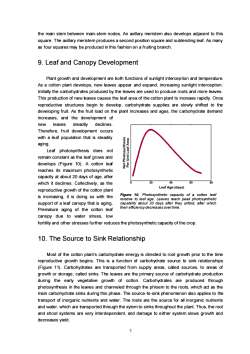
themain stembetweenmain-stemnodes.Anaxillarymeristemalsodevelops adjacenttothissquare.Theaxillarymeristemproduces a secondposition squareand subtending leaf.Asmanyas four squaresmay be produced in this fashion on afruiting branch.9.LeafandCanopyDevelopmentPlant growth and development are both functions of sunlight interception and temperature.Asacottonplantdevelops,newleavesappearandexpand,increasingsunlightinterception.InitiallythecarbohydratesproducedbytheleavesareusedtoproducerootsandmoreleavesThisproductionof newleaves causestheleaf area of thecottonplantto increaserapidly.Oncereproductive structures begin to develop, carbohydrate supplies are slowly shifted to thedeveloping fruit. As the fruit load on the plant increases and ages, the carbohydrate demandincreases, and the development ofnewleavessteadilydeclines.Therefore, fruit development occurswith a leaf population that is steadilyaging.Leafphotosynthesisdoesnotremainconstantastheleafgrowsanddevelops (Figure 10). A cotton leafreaches its maximum photosyntheticcapacityat about20 days of age,after20which it declines. Collectively, as theLeaf Age (days)reproductive growth of the cotton plantFigure10.Photosynthetic capacityof a cotton leafis increasing, it is doing so with therelativetoleafage.Leavesreachpeakphotosyntheticsupport of a leaf canopy that is aging.capability about 20 days after they unfoid, after whichtheirefficiencydecreasesovertimePremature aging of the cotton leafcanopyduetowaterstress,lowfertilityandotherstressesfurtherreducesthephotosyntheticcapacityofthecrop.10.TheSourcetoSinkRelationshipMostof thecottonplant'scarbohydrate energyis directedtorootgrowthpriortothetimereproductive growth begins.This is a function of carbohydrate source to sink relationships(Figure 11). Carbohydrates are transported from supply areas, called sources, to areas ofgrowthorstorage,called sinks.Theleavesaretheprimarysourceofcarbohydrateproductionduring the early vegetative growth of cotton. Carbohydrates are produced throughphotosynthesisintheleavesandchanneledthroughthephloemtotheroots,whichactasthemain carbohydrate sinks during this phase. The source-to-sink phenomenon also applies to thetransport of inorganic nutrients and water.The rootsarethesourcefor all inorganicnutrientsandwater,whicharetransportedthroughthexylemto sinksthroughouttheplant.Thus,therootand shoot systems are very interdependent, and damage to either system slows growth anddecreases yield.7
7 the main stem between main-stem nodes. An axillary meristem also develops adjacent to this square. The axillary meristem produces a second position square and subtending leaf. As many as four squares may be produced in this fashion on a fruiting branch. 9. Leaf and Canopy Development Plant growth and development are both functions of sunlight interception and temperature. As a cotton plant develops, new leaves appear and expand, increasing sunlight interception. Initially the carbohydrates produced by the leaves are used to produce roots and more leaves. This production of new leaves causes the leaf area of the cotton plant to increase rapidly. Once reproductive structures begin to develop, carbohydrate supplies are slowly shifted to the developing fruit. As the fruit load on the plant increases and ages, the carbohydrate demand increases, and the development of new leaves steadily declines. Therefore, fruit development occurs with a leaf population that is steadily aging. Leaf photosynthesis does not remain constant as the leaf grows and develops (Figure 10). A cotton leaf reaches its maximum photosynthetic capacity at about 20 days of age, after which it declines. Collectively, as the reproductive growth of the cotton plant is increasing, it is doing so with the support of a leaf canopy that is aging. Premature aging of the cotton leaf canopy due to water stress, low fertility and other stresses further reduces the photosynthetic capacity of the crop. 10. The Source to Sink Relationship Most of the cotton plant’s carbohydrate energy is directed to root growth prior to the time reproductive growth begins. This is a function of carbohydrate source to sink relationships (Figure 11). Carbohydrates are transported from supply areas, called sources, to areas of growth or storage, called sinks. The leaves are the primary source of carbohydrate production during the early vegetative growth of cotton. Carbohydrates are produced through photosynthesis in the leaves and channeled through the phloem to the roots, which act as the main carbohydrate sinks during this phase. The source-to-sink phenomenon also applies to the transport of inorganic nutrients and water. The roots are the source for all inorganic nutrients and water, which are transported through the xylem to sinks throughout the plant. Thus, the root and shoot systems are very interdependent, and damage to either system slows growth and decreases yield. Figure 10. Photosynthetic capacity of a cotton leaf relative to leaf age. Leaves reach peak photosynthetic capability about 20 days after they unfold, after which their efficiency decreases over time
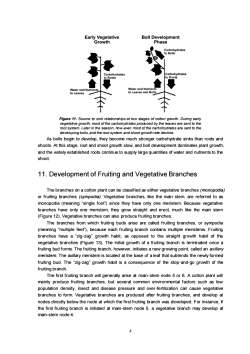
EarlyVegetativeBoll DevelopmentGrowthPhaseCarbohydratestoBollsCarbohydratesCarbohydratestoRootstoRootsWaterandNutrientsWater and Nutrientsto LeavesandBollto LeavesFigure11.Sourcetosinkrelationshipsattwostagesofcottongrowth.Duringearlyvegetativegrowth,mostofthe carbohydratesproduced bythe leaves are sentto theroot system.Later in theseason,how-ever,mostofthe carbohydrates are senttothedevelopingbolls,andtherootsystemandshootgrowthratedecline.Asbollsbegintodevelop,theybecomemuchstrongercarbohydrate sinksthanrootsandshoots.Atthis stage,rootandshoot growth slow,and boll developmentdominatesplantgrowthandthewidelyestablished rootscontinuetosupplylargequantitiesofwaterand nutrientstotheshoot.11.Development of Fruiting and Vegetative BranchesThebranches on a cotton plant can be classified as either vegetative branches (monopodia)or fruiting branches (sympodia). Vegetative branches, like the main stem, are referred to asmonopodia(meaning“singlefoot)sincetheyhaveonlyone meristem.Because vegetativebranches have only one meristem, they grow straight and erect, much like the main stem(Figure12).Vegetativebranchescanalsoproducefruitingbranches.The branches fromwhich fruiting buds arise are called fruiting branches, or sympodia(meaning “multiple feet'), because each fruiting branch contains multiple meristems. Fruitingbranches have a “zig-zag” growth habit, as opposed to the straight growth habit of thevegetative branches (Figure 13).The initial growth of a fruiting branch is terminated once afruiting bud forms. The fruiting branch, however, initiates a new growing point, called an axillarymeristem.Theaxillarymeristemislocated at thebaseofaleaf that subtendsthenewlyformedfruiting bud. The“zig-zag" growth habit is a consequence of the stop-and-go growth of thefruitingbranchThefirstfruitingbranchwill generally arise at main-stemnode5or6.A cottonplant willmainly producefruitingbranches,but several common environmental factors such as lowpopulation density, insect and disease pressure and over-fertilization can cause vegetativebranches toform.Vegetativebranchesareproduced afterfruitingbranches,anddevelop atnodesdirectlybelowthenodeatwhichthefirstfruitingbranchwasdeveloped.For instance,ifthefirst fruiting branch is initiated atmain-stem node5,a vegetative branchmay develop atmain-stem node4.8
8 Figure 11. Source to sink relationships at two stages of cotton growth. During early vegetative growth, most of the carbohydrates produced by the leaves are sent to the root system. Later in the season, how-ever, most of the carbohydrates are sent to the developing bolls, and the root system and shoot growth rate decline. As bolls begin to develop, they become much stronger carbohydrate sinks than roots and shoots. At this stage, root and shoot growth slow, and boll development dominates plant growth, and the widely established roots continue to supply large quantities of water and nutrients to the shoot. 11. Development of Fruiting and Vegetative Branches The branches on a cotton plant can be classified as either vegetative branches (monopodia) or fruiting branches (sympodia). Vegetative branches, like the main stem, are referred to as monopodia (meaning “single foot”) since they have only one meristem. Because vegetative branches have only one meristem, they grow straight and erect, much like the main stem (Figure 12). Vegetative branches can also produce fruiting branches. The branches from which fruiting buds arise are called fruiting branches, or sympodia (meaning “multiple feet”), because each fruiting branch contains multiple meristems. Fruiting branches have a “zig-zag” growth habit, as opposed to the straight growth habit of the vegetative branches (Figure 13). The initial growth of a fruiting branch is terminated once a fruiting bud forms. The fruiting branch, however, initiates a new growing point, called an axillary meristem. The axillary meristem is located at the base of a leaf that subtends the newly formed fruiting bud. The “zig-zag” growth habit is a consequence of the stop-and-go growth of the fruiting branch. The first fruiting branch will generally arise at main-stem node 5 or 6. A cotton plant will mainly produce fruiting branches, but several common environmental factors such as low population density, insect and disease pressure and over-fertilization can cause vegetative branches to form. Vegetative branches are produced after fruiting branches, and develop at nodes directly below the node at which the first fruiting branch was developed. For instance, if the first fruiting branch is initiated at main-stem node 5, a vegetative branch may develop at main-stem node 4
按次数下载不扣除下载券;
注册用户24小时内重复下载只扣除一次;
顺序:VIP每日次数-->可用次数-->下载券;
- 《作物栽培学》课程教学大纲(作物栽培学双语教学大纲).doc
- 《作物栽培学》课程教学大纲(作物研究法综合实验大纲).doc
- 《作物栽培学》课程教学大纲(农学实践基础)Principle of Basis on Agronomy Practice.doc
- 《作物栽培学》课程教学大纲(作物高产生理学综合实验大纲).doc
- 《作物栽培学》课程教学大纲(农学实践基础)Agronomy Practice.doc
- 《作物栽培学》课程教学大纲(作物栽培生理研究法)Crop Cultivation Physiology and Research Technique.doc
- 《作物栽培学》课程教学大纲(作物栽培学专题)Topic on Crop Cultivation Science.doc
- 《作物栽培学》课程实验指导(PPT讲稿)实验三 小麦幼穗分化的观察-1/2.ppt
- 《作物栽培学》课程实验指导(PPT讲稿)实验二 小麦、大麦、燕麦和黑麦的形态特征观察及亚种的识别.ppt
- 《作物栽培学》课程实验教学大纲(农学).doc
- 《作物栽培学》课程实验教学大纲(植保).doc
- 《作物栽培学》课程实验指导(PPT讲稿)实验三 小麦幼穗分化的观察-2/2.ppt
- 《作物栽培学》课程实验指导(PPT讲稿)实验四 玉米形态特征及类型识别-1/2.ppt
- 《作物栽培学》课程实验指导(PPT讲稿)实验四 玉米形态特征及类型识别-2/2.ppt
- 《作物栽培学》课程实验指导(PPT讲稿)实验六 棉花的形态观察及四个栽培棉种识别.ppt
- 《作物栽培学》课程实验指导(PPT讲稿)实验八 油菜的形态特征观察及经济性状分析.ppt
- 《作物栽培学》课程实验指导(PPT讲稿)实验五 水稻种子发芽特征观察.ppt
- 《作物栽培学》课程实验指导(PPT讲稿)实验九 甜菜形态结构观察及块根含糖量测定.ppt
- 《作物栽培学》课程实验指导(PPT讲稿)实验七 棉花测产.ppt
- 《作物栽培学》课程实验指导(PPT讲稿)实验十 稻米外观品质测定.ppt
- 《作物栽培学》课程教学资源(讲义)Wheat growth and management.doc
- 《作物栽培学》课程教学课件(PPT讲稿)第七章 油菜栽培.ppt
- 《作物栽培学》课程教学课件(讲稿)第十章 加工番茄栽培技术.pdf
- 《作物栽培学》课程教学课件(PPT讲稿)第九章 甜菜栽培.ppt
- 《作物栽培学》课程教学课件(PPT讲稿)第八章 大豆栽培.ppt
- 《作物栽培学》课程教学课件(PPT讲稿)第三章 水稻栽培.ppt
- 《作物栽培学》课程教学课件(PPT讲稿)第六章 向日葵栽培.ppt
- 《作物栽培学》课程教学课件(PPT讲稿)第五章 棉花栽培.ppt
- 《作物栽培学》课程教学课件(讲稿)第二章 小麦栽培.pdf
- 《作物栽培学》课程教学课件(讲稿)第四章 玉米栽培.pdf
- 《作物栽培学》课程教学课件(PPT讲稿)第一章 概论.ppt
- 《农业昆虫学》课程教学大纲 Agricultural Entomology.pdf
- 《农业昆虫学》课程考试大纲 Agricultural Entomology.pdf
- 《农业昆虫学》课程授课教案(石河子大学:张建萍).doc
- 《农业昆虫学》课程各章习题集(无答案).doc
- 《农业昆虫学》课程作业试题库(无答案).doc
- 《农业昆虫学》课程教学实验指导书(共十二个实验).doc
- 《农业昆虫学》课程教学资源(PPT课件)第十一章 棉花害虫(蓟马类、盲蝽蝽).pps
- 《农业昆虫学》课程教学资源(PPT课件)第十一章 棉花害虫(棉蚜 cotton aphid).pps
- 《农业昆虫学》课程教学资源(PPT课件)第十章 粮食作物害虫.pps
